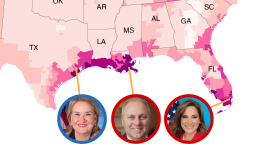As climate change increases sea level, fuels more extreme rainfall and supercharges hurricanes, American businesses are set to collectively lose millions of days of operation in coming years due to flood-related damages, according to a new report.
Damage from flooding in the US costs billions of dollars each year, according to the National Oceanic and Atmospheric Administration. And a new analysis by First Street Foundation, a nonprofit research and technology group that assesses flood risks, and Arup, a commercial engineering firm, found that retail, office and multi-unit residential properties stand to lose more than $13.5 billion in 2022 from flood damage.
In addition to the direct damage, these businesses would collectively lose 3.1 million days of operation in 2022 as they recover from flood events. The days lost would affect companies’ financial stability as well astheir employees’ income, according to the report.
As the climate crisis accelerates and flooding becomes more frequent and more severe, the annual cost to business will increase as well. In 30 years, damage costs will reach $16.9 billion and the days lost will climb to 4 million, the report estimates.
Jeremy Porter, the head of research and development at First Street, said that it’s been a struggle to assess the impact of flooding on businesses until recently.
“There’s a huge amount of data that exists for flooded residential properties and the claims that were paid out against those damages,” Porter told CNN. “For commercial properties, nothing exists.”
Matthew Eby, First Street’s founder and executive director, said the firm plans to make the report’s data available to commercial property owners and government leaders for free to help them asses flood risk of current or future properties.
Scientists reported in August that human-caused climate change is making flood events worse around the globe. This happens because warmer air can hold more water. For example, storms like Hurricane Harvey, which flooded southeast Texas in 2017, not only slam coasts with storm surge and damaging winds, but also cause more intense inland deluges because of global warming.
The ramifications were evident when two recent storms — Henri and Ida — broke rainfall records in the Northeast within two weeks. In September, the remnants from of Hurricane Ida inundated parts of New York City with more than 7 inches of rain, laying bare just how poorly equipped American infrastructure is for what climate change has in store.

Researchers predict that Florida, one of the states most vulnerable to climate change, will in 2022 incur the largest structural damage costs in the nation across all office and retail buildings, as well as days of inoperability due to repairs.
Some businesses are already relocating their corporate offices away from vulnerable areas like Florida and Texas. The researchers pointed out that Spirit Air, for instance, announced last year it would relocate its operations center to Nashvilledue to flooding and worsening storms in Florida.
“When a business has to close for flood repair, it incurs the cost of repair, but it also means lost days of productivity, earnings, and output for its workers, and associated disruptions to the broader economic ecosystem of which that business is a part,” Porter said.
Among metropolitan areas, Miami bears the highest costs in structural damage due to flooding, according to the report. By 2040, sea level in the Miami area is expected to climb 10 to 17 inches higher than 2000 levels, according to an analysis by Miami-Dade County officials.
Still, the area continues to be a hot tourist hub, making it a prime location for businesses. Miami Beach has already spent millions of dollars elevating roads, upgrading pumps and changing building codes to allow residents to raise their homes. Meanwhile, real estate and commercial developers are retreating to higher ground.
A recent report by the World Meteorological Organization found the financial costs and lost incomes associated with each extreme weather and climate-related disaster have been mounting dramatically, accounting for three-quarters of all reported economic losses. And the report shows storms and floods caused the largest economic losses.
Six of the most expensive weather and climate-related disasters around the world happened in the US, according to the WMO, and three occured in 2017 alone: Hurricane Harvey in Texas caused $96.9 billion in losses; Hurricane Maria in Puerto Rico caused $69.4 billion; and Hurricane Irma, which hit Florida — along with the Caribbean — caused $58.2 billion, according to the WMO.
Eby told CNN that businesses need the ability to plan, invest and grow their operations as climate change intensifies extreme weather.
“Now that climate risk is measurable in dollars and cents, business owners as well as leaders at the city, state and national level will find it hard to ignore the implications, and be better informed on how to mitigate the risk,” Eby said.










